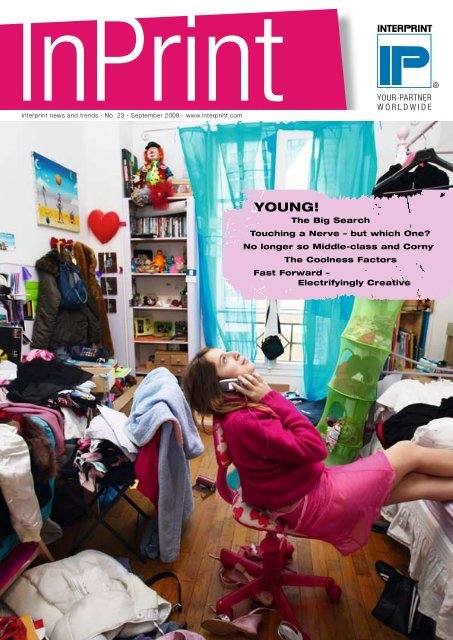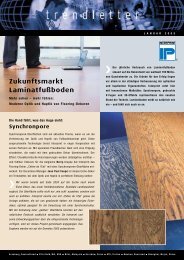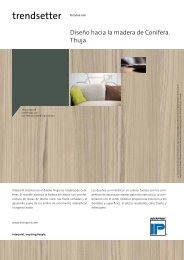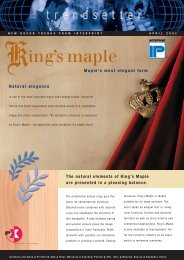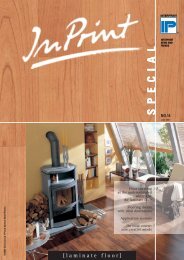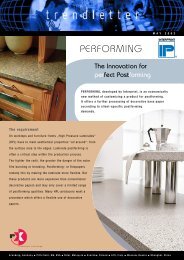InPrint - interprint
InPrint - interprint
InPrint - interprint
You also want an ePaper? Increase the reach of your titles
YUMPU automatically turns print PDFs into web optimized ePapers that Google loves.
<strong>InPrint</strong><br />
Interprint news and trends · No. 23 · September 2008 · www.<strong>interprint</strong>.com<br />
Young!<br />
The Big Search<br />
Touching a Nerve – but which One?<br />
No longer so Middle-class and Corny<br />
The Coolness Factors<br />
Fast Forward –<br />
Electrifyingly Creative
2 | <strong>InPrint</strong> 23 | EDITORIAL<br />
Dear Readers,<br />
“The young are ‘the forgotten ones' of the furniture industry and the<br />
furniture supply industry.” With this provoking statement, Salvatore<br />
Figliuzzi opened up a fascinating discussion in the last edition of<br />
<strong>InPrint</strong>, which is still continuing today. The time seems ripe for a new<br />
way of thinking, which incorporates the young generation as today’s<br />
(or subsequent) consumers. As studies confirm: more than two thirds<br />
of consumers have already found their favorite brands by the age of<br />
17. And: the brand preference of young people is also well received<br />
by “established” target groups. Therefore, other high-price industries<br />
such as the fashion and electronics industries have long since included<br />
young people in their communications.<br />
Due to the enormous response, we have dedicated the <strong>InPrint</strong> Young!<br />
special edition, now lying in front of you, to this subject. It is based<br />
on the question: with what products and using which communication<br />
channels can the furniture industry better reach young people? To<br />
find the answers, Interprint commissioned the Münster University of<br />
Applied Sciences to carry out a study. We are inviting you to share in<br />
some of the very interesting findings. An advance summary: the target<br />
group is anything but standardised. Be it pupil, apprentice or student,<br />
boy or girl, 14 or 23 – all this makes more than a difference. Therefore,<br />
as you leaf through <strong>InPrint</strong>, you will come across six young “types”,<br />
who are representative of certain aspects in the market segment of<br />
this generation. The characterization helps to make the target group<br />
more understandable in its very different characteristics as well as<br />
deducing communication strategies.<br />
In addition, based on three successful youth brands, this magazine<br />
shows how the target group can be won over with an address about<br />
the aspects of lifestyle, design and brand. And finally, there is an<br />
interview with Dirk Uwe Klaas, the managing director of the Verband<br />
der deutschen Möbelindustrie (the head association of the German<br />
furniture industry).<br />
Why this commitment even though we are not especially present in<br />
the consumer market as decor printers? Because decor influences<br />
furniture and flooring trends. Because the appearance and quality<br />
of surfaces can provide the young group of consumers with decisive<br />
stimuli. And because this market segment offers our entire industry<br />
a big potential. The stimulus for us is also the new Interprint design<br />
philosophy “Fast Forward”, which is met with huge interest on the<br />
market. It is presumably so successful because it does not just represent<br />
a melodious concept of ideology. In fact, creative processes<br />
for innovative decor, the discovery of new sources of inspiration and<br />
the cross-industry cooperation with partners, media and universities<br />
produces very practical answers to issues for the future. One of these<br />
is how we, as decor printers, together with our customers, can reach<br />
young people.<br />
We hope you enjoy this stimulating read!<br />
Yours,<br />
Holger Dzeia
Content | <strong>InPrint</strong> 23 | 3<br />
Content<br />
The Big Search<br />
Start Young: Brand preferences are developed early on<br />
Touching a Nerve – but which One?<br />
Results of a study by the Münster University of Applied<br />
Sciences on the subject of “Youth Living”<br />
“No longer so Middle-class and Corny”<br />
Interview with Dirk-Uwe Klaas, chief executive of the<br />
Verband der deutschen Möbelindustrie<br />
The Coolness Factors<br />
Lifestyle, Brand and Design make a brand desirable<br />
Electrifyingly Creative<br />
Salvatore Figliuzzi about the Interprint Design Philosophy<br />
“Fast Forward”<br />
Thanks<br />
To the project group of the Münster<br />
University of Applied Sciences<br />
04<br />
07 – 10<br />
13 – 14<br />
16 – 17<br />
18 – 19<br />
20<br />
Strong Types!<br />
Anna-Lena, Daniel, Sebastian, Melanie, Stephanie,<br />
Philip: In this edition of <strong>InPrint</strong>, we<br />
introduce 6 young types who are representative<br />
of the target group of young adults. Meet<br />
our 6 protagonists in their dream rooms! Attention:<br />
Names and situations are imaginary.<br />
The selection is not representative. This characterisation<br />
by age, gender, education and<br />
living situation is intended more to analyse<br />
the relevant aspects in the market segment<br />
of the young generation.<br />
Imprint<br />
Publisher: INTERPRINT GmbH<br />
Westring 22 · 59759 Arnsberg · Germany<br />
Telephone: +49 (0) 2932 - 950-0 · Telefax: +49 (0) 2932 - 950-109<br />
info@<strong>interprint</strong>.de · www.<strong>interprint</strong>.com<br />
Responsible for the contents: Elisabeth Zenker · Editor: Leo Bisping<br />
Layout: Dassel-Design GmbH · Text contributions: Olivia C. Rost<br />
We thank the following companies for the pictures they have<br />
provided:<br />
Bruehl, Bad Steben (P. 14), Corbin-Wohndesign, Landstuhl (P. 11),<br />
die Collection, Buchen/Odenwald (P. 14), Fritz Hansen, Allerød<br />
Dänemark (P. 15), Hülsta, Stadtlohn (P. 5, 11, 13, 14),<br />
IKEA, Hofheim-Wallau (P. 6, 9, 12), Reisenthel, Gilching (P. 14),<br />
Röhr-Bush, Rietberg (P. 5), Rolf Benz, Nagold (P. 11, 15),<br />
sitzsack.de, Sonneberg (P. 6), Sonic Chair, Köln (P. 14).
4 | <strong>InPrint</strong> 23 | The Big Search<br />
The Big Search<br />
Being young is a full-time job. What is “hip” today might be well and truly annoying by<br />
tomorrow. A mirror of these huge upheavals is the young person’s own bedroom. And even<br />
if young people don’t have a lot of money of their own, brand awareness is keener between<br />
the ages of 12 and 18 than it is in any other phase of a person’s life.<br />
The cuddly bear on the bed. A poster of Timberland on the wall. The<br />
model railway on the floor. A gallery of alcopop bottles on the shelf.<br />
Adolescence: the most exciting and most difficult time in your life.<br />
New realms of experience are unlocked. The search for a new, grownup<br />
personality begins. You want to go forward but, all too often, you’re<br />
not quite yourself. Your parents don’t understand anything – and that’s<br />
a good thing!<br />
The body is changing. Your preferences too. The older the young<br />
person, the more important friends, cafes and cinemas become, while<br />
your interest in family, sports and toys declines at the same speed.<br />
The favorite pastimes of teens can be listed quickly: “just talking,<br />
chatting” is preferred by 75 percent, followed by “going shopping”<br />
(59 percent) and “hanging out outside” (51 percent)*. Recognition<br />
within the group contradicts the desire for an individual identity.<br />
No Admittance!<br />
Nothing expresses the changing interests of this period better than<br />
your own room. The more puberty advances, the more important this<br />
private space becomes, as a study about youth living carried out by<br />
the Münster University of Applied Sciences commissioned by Interprint<br />
confirms. Quote from an interviewed 15-year old girl: “My room is<br />
more an area where I am alone. Not every Tom, Dick and Harry should<br />
gain access.” Only your closest friends have free access to where<br />
you’re most important pieces of furniture, sofa, bed (for chilling) and<br />
desk (for the computer) are. Those who still have their old children’s<br />
furniture find it really embarrassing when someone visits.<br />
The long-term loyalty: Furniture brands are discovered early on<br />
It has been proven: somewhere around the age of 12, brand awareness<br />
begins to form. It increases very sharply until the age of 17<br />
before slowing down, until it is fixed at about the age of 22. When<br />
the door to your first apartment opens, a person already has a “brand<br />
career” spanning several years behind them. More than two thirds of<br />
consumers have already found their favorite brands by the age of 17.<br />
And this which manifests as a preference during this period is often<br />
more long-lasting than first love.<br />
For young people, brands play a central role as they provide a focus<br />
to overcome everyday life, aid acceptance and integration into groups<br />
of friends and stabilize self-awareness. This also applies for furniture<br />
brands. Even when you don’t have much money of your own, teenagers<br />
are already looking around attentively to find what furniture<br />
appeals to them and have great influence over their parents. Furniture<br />
and accessories appeal to the requirement for lifestyle, design and<br />
brand strength – factors, which generally score points among young<br />
people. As well as other popular brands, furniture brands help you to<br />
discover your personal preferences. They form the style and are the<br />
foundations for what you might like or reject in your own four walls as<br />
an adult.<br />
* According to the “Trend barometer 2007” in German youth magazine Bravo
TypE 1 | <strong>InPrint</strong> 23 | 5<br />
Type 1: Anna-Lena, 15, Student<br />
Photo: Hülsta<br />
Creative answers to rapidly changing trends: the “mobiline trend”<br />
range by furniture manufacturer Röhr-Bush can change its appearance<br />
every day by putting inserts in glass panes or using furniture and wall<br />
tattoos.<br />
Photo: Hülsta<br />
“I want to be able to change my furniture.”<br />
Anna-Lena lives with her brother and her single mother. Her room is primarily a retreat<br />
(“cocooning”) and a place to chill out and chat with her friends. Her idea: flexible, changeable<br />
furniture, like a sofa bed, adjustable table and shelves. Design lines with round, soft forms,<br />
pastel colours and combinable patterns appeal to her. She would like the chance to virtually<br />
create her room and furniture.<br />
Address through Lifestyle and Design<br />
For the high school student, furniture is interesting when it is presented in connection with<br />
her peers and conveys an atmosphere of friendship and fun. She likes to read youth magazines<br />
and loves programmes like “Deutschland sucht den Superstar” and “Schloss Einstein”,<br />
which is a fictional programme about boarding school. In this environment, advertising for<br />
the target group of very young girls gains the largest publicity. On the net, it is the sites of<br />
“My Space” and “schülerVz” that Anna-Lena likes to visit the most.<br />
Likes:<br />
riding, boys, cinema, going out<br />
Doesn’t like:<br />
little brother,<br />
coaching, cauliflower<br />
Media:<br />
DSDS, Germany’s Next Topmodel, VIVA<br />
Newspapers and web:<br />
Sugar, Bravo Girl, ICQ, MySpace
6 | <strong>InPrint</strong> 23 | Type 2<br />
Type 2: Daniel, 15, High School Student<br />
“I need more space!”<br />
15-year old Daniel lives with his parents and has relatively little space in his “digs”.<br />
For him, furniture must be “practical and cool” above all. The high school student would<br />
love a system, with which he could “splice together” various elements.<br />
Photos (3): Inter IKEA Systems B.V.<br />
Address through Design and Brand<br />
Where does Daniel find his desired furniture and how does the furniture industry find Daniel? Best through the<br />
internet, because as a computer freak, he would rather use the lively online tools, with which he can compile<br />
his furniture parts. Other media are sports magazines and computer magazines, which present design ideas in<br />
connection with technology and communicate the aspects “practically” and in a “space-saving” manner.<br />
Likes:<br />
Computer games, chatting, football<br />
Doesn’t like:<br />
French, homework, tidying up<br />
Favorite programmes:<br />
sports, action films<br />
Newspaper and web:<br />
Kicker, ICQ
Touching a Nerve | <strong>InPrint</strong> 23 | 7<br />
Touching a Nerve – but which One?<br />
Youth is not a status. It is more of a constantly evolving process. Optimal communication<br />
is as different as the expectations of the target group. A study, commissioned by Interprint<br />
by the Münster University of Applied Sciences, shows this.<br />
Even with the definition of age, people start to falter: does youth<br />
begin at 12 or 14? Does it end at 20, 23 or 25? What do a 16-year old<br />
apprentice and a 23-year old student have in common? Presumably<br />
very little. The “young people” as a homogeneous group does<br />
not exist. However, there are sections of youth reality which have<br />
significance. In cooperation with the Münster University of Applied<br />
Sciences, Interprint carried out a characterisation of young people in<br />
accordance with gender; age and educational situation (see the six<br />
“types” in this edition of <strong>InPrint</strong>).<br />
Salvatore Figliuzzi, manager of repro/decor development at Interprint<br />
Germany says, “The living circumstances of these six characters<br />
are as different as their expectations on living. However, there are<br />
similarities, from which solutions for products and their communication<br />
can be deduced.”<br />
Because I am a Girl<br />
Perhaps the most important criterion is gender. Not only are girls more<br />
advanced than boys in their development, they also (no wonder) put<br />
considerably more significance on the design of their room or their<br />
first apartment. Girls, in turn, are not all the same girls. The 18-year<br />
old apprentice Melanie wants to represent herself with her first furniture;<br />
21-year old student Stephanie wants to distance herself. Even<br />
with boys, the following applies: anyone who lives with their parents<br />
as a school pupil has different demands on the design of their room<br />
than the studying son of well-heeled parents.
8 | <strong>InPrint</strong> 23 | Touching a Nerve<br />
The Common Denominator: Individuality and Flexibility<br />
With all six types of youths, the desire for individuality, mobility and<br />
flexibility are very distinct. Young people rarely want to have readymade<br />
range put in front of them. Much more, they want to act out their<br />
own style or even create one. A dream room made up of elements of<br />
various ranges, in which personal “cult pieces” set the focus, would<br />
be the ideal solution for most young people. The internet provides<br />
countless opportunities to design your own products (shoe design<br />
at “NIKE” or “Converse”, online rooms at “Praktiker”). It is almost a<br />
prerequisite that you can put together your own room virtually with the<br />
furniture and accessories ranges of the furniture manufacturer.<br />
Modular Systems and Furniture Subscriptions<br />
What type of furniture do young people want? For example, it should<br />
be light, flexible, mobile and changeable. The big plus point is given<br />
to a modular system with flexible surfaces. With different decorative<br />
surfaces and other exchangeable elements, shelving elements, table<br />
panels and cabinet fronts could get a new outfit very easily. Salvatore<br />
Figliuzzi says, “When the idea is considered further, a “furniture subscription”<br />
would offer many advantages as the design could grow with<br />
the young people and satisfy the quick-changing trends. Above all, it<br />
would help to save money.” The advantage for the furniture manufacturer:<br />
an early and long-term connection to the brand. <br />
What is important to young people<br />
% 70<br />
60<br />
50<br />
40<br />
30<br />
20<br />
10<br />
0<br />
Age 12-13 Age 14-15 Age 16-17 Age 18<br />
friends<br />
school/career<br />
parents/family<br />
money/possessions<br />
sports<br />
animals<br />
Friends are the most<br />
important thing in life<br />
for all young people.<br />
Parents increasingly lose<br />
their importance. Finishing<br />
school and choosing a<br />
career become the central<br />
themes – just like money,<br />
which you never have<br />
enough of.<br />
How you see yourself – and how you’d like to be<br />
Reliable,<br />
honest<br />
intelligent<br />
normal<br />
chaotic<br />
dreamy<br />
modest<br />
reserved,<br />
shy<br />
59 47<br />
selfconfident<br />
40 61<br />
43 23<br />
successful<br />
34 58<br />
43 33<br />
cool<br />
14 55<br />
36 cute, 25<br />
13<br />
good looking<br />
51<br />
34<br />
sophisticated, 28<br />
15 clever<br />
48<br />
31 16<br />
exciting, sexy<br />
15 44<br />
30 superior, 18<br />
better than others<br />
13 39<br />
I am<br />
I would like to be<br />
The study “Bravo Faktor<br />
Jugend 7” from 2004 shows<br />
how young people see themselves<br />
and how they want to<br />
be. Accordingly, there is a<br />
gaping hole between desire<br />
and reality: For example,<br />
more than half of those asked<br />
would love to be “cool”,<br />
but only a third see themselves<br />
in this way. There is a<br />
similar ration when it comes<br />
to appearance: only 25 percent<br />
of young people see<br />
themselves as good looking<br />
while more than twice this<br />
number would like to be.<br />
28 percent of the young interviewees<br />
see themselves as<br />
“sophisticated, clever”, but<br />
48 percent would like to be.<br />
In comparison, 59 percent<br />
see themselves as reliable<br />
and honest while just 40 percent<br />
want to be this way.
Type 3 | <strong>InPrint</strong> 23 | 9<br />
Photos (4): Inter IKEA Systems B.V.<br />
Type 3: Melanie, 18, Dental Assistant Apprentice<br />
“Chilling is the best!”<br />
Melanie lives with her boyfriend. She likes furniture that can be<br />
individualised, for example with layers and changeable surfaces.<br />
The apartment must be both cozy (retreat for her and her boyfriend)<br />
and chic (meeting place with friends). A design line with<br />
matching elements is important to her. She is happy to sacrifice<br />
part of her salary for nice furniture.<br />
Address through Design and Lifestyle<br />
Melanie likes it when media conveys a lifestyle atmosphere: being<br />
happy with friends, having fun, throwing parties. Her “house<br />
media” are women’s magazines and TV programmes like “Das<br />
perfekte Promi Dinner”, Germany’s version of “Come Dine with<br />
me” and “Germany’s Next Topmodel”. As she is interested in the<br />
topic of living, she also likes the smart design shows. On the<br />
internet, Melanie is interested in cosmetic and health sites, which<br />
also represent a suitable presentation area for living spaces.<br />
Likes:<br />
nail studio, fitness studio,<br />
solarium, shopping, chilling<br />
Doesn’t like:<br />
housework, clearing up after<br />
her boyfriend, football<br />
Favourite programme:<br />
GNT, GZSZ, Verbotene Liebe<br />
Newspaper and web:<br />
Chica, Jolie, Joy, Lokalisten.de
10 | <strong>InPrint</strong> 23 | Touching a Nerve<br />
Brand as Friend or Brand as Rebel?<br />
The study also produced another similarity: who produces role models,<br />
for example groups of friends and cliques in certain worlds is<br />
hitting the nerves of young people. You go through life together. The<br />
brand is a reliable friend. For these scenes, furniture offers the ideal<br />
background for the action. The sofa to cuddle up on, the kitchenette<br />
for communal cooking, the “debating” table, the dolled-up bathroom:<br />
furniture is brought to life and emotionally charged. Its stages are<br />
websites, catalogues, advertisements and cinema and TV sports.<br />
Anyone who positioned their products in “Deutschland sucht den<br />
Superstar” or “Germany’s Next Topmodel” or uses the commercial<br />
breaks for their message will immediately have a captive audience of<br />
millions. The success of these programs is also based on the fact that<br />
the young people sympathise or join in the enjoyment.<br />
At the same time, young consumers question old-fashioned products.<br />
However, even differentiation requires identification. Brands which<br />
want to rise above the mainstream, must find a certain number of<br />
“rebels” first of all, who wear this image in the world and make wearing<br />
it or using it successful. Differentiation only works if young people do<br />
not drift into isolation.<br />
Salvatore Figliuzzi says, “The results of the study show the high significance<br />
of creativity, mobility and design to develop a young person’s<br />
own style. For Interprint, there is another challenge in promoting the<br />
claim to the design philosophy ‘Fast Forward’ with even more force:<br />
we want to look forward creatively as a ‘trendsetter’ and be the first to<br />
professionally implement decor ideas on the market.”<br />
Summary<br />
Anyone who wants to be successful as a furniture brand in the youth market:<br />
Shows flexibility and choices in their product range,<br />
Connects the theme of design with the attitude towards life of young people,<br />
Offers them identification choices (“emotional home”) as well as chances<br />
to differentiate from the mainstream,<br />
Ensures lively communication in “youth media”.
Type 4 | <strong>InPrint</strong> 23 | 11<br />
Type 4: Sebastian, 17, Apprentice<br />
Photo: Hülsta<br />
Photo: Hülsta<br />
“Furniture doesn’t have to cost a lot.”<br />
Sport and technology are the biggest weaknesses of Sebastian, which his furniture should also reflect.<br />
The 17-year old lives with his mother and is doing an apprenticeship to become a vehicle mechatronics<br />
technician. His furniture must be cheap, multi-functional, cool, angular and not too comfy! He has fun with<br />
“cult details”, like old car seats as armchairs.<br />
Address through Lifestyle, Technology, Brand<br />
As Sebastian has to count his money and think practically, he reacts positively to multi-functionalism and<br />
design. He likes the internet less than car and sports journals, car programmes like “pimp my ride” and<br />
the radio, which he listens to in the garage all day long. Advertisements, spots, product placement and PR<br />
reports reach him if they are charged with technology, action and masculinity. Sebastian could be interested<br />
in sample rooms at car exhibitions, like a chilling corner.<br />
Likes:<br />
BBQs, beer, girls,<br />
football, bongs, tuning<br />
Doesn’t like:<br />
pop songs, vocational school,<br />
Sunday drivers<br />
Favourite programmes:<br />
Auto Motor Sport, D-Max<br />
Newspaper and web:<br />
Auto-Bild, no internet
12 | <strong>InPrint</strong> 23 | Type 5<br />
Type 5: Stephanie, 21, Trainee Teacher<br />
“The main thing is naturalness!”<br />
Address through Lifestyle<br />
Friendly, cozy shared accommodation atmosphere, nice evenings,<br />
Stephanie lives in a shared accommodation and is single. She prefers<br />
spending time with friends, communal cooking, natural surrounding:<br />
simple design with multi-functional furniture, supplemented by individual<br />
pieces (preferably antique). Cult brands enjoy more kudos than<br />
anyone who conveys these lifestyles will reach Stephanie. Her media<br />
are the internet (studiVz, Facebook, MySpace), daily newspapers,<br />
the current, established brands. She spends a lot of time with friends in<br />
living magazines, health and women’s magazines. She only appreciates<br />
television advertising between series and talk shows if they are<br />
the large breakfast kitchen. For her, design must be cozy, natural and<br />
individual.<br />
funny and stylish.<br />
Photos (4): Inter IKEA Systems B.V.<br />
Likes:<br />
Vegetarian food,<br />
children, parties, 1Live<br />
Doesn’t like:<br />
Rock ’n Roll, Punk, spiders, smokers<br />
Favourite programmes:<br />
Talk shows, Auf und Davon,<br />
Das perfekte Dinner<br />
Web:<br />
Meetic, Neu.de, 1Live Liebesalarm
Interview | <strong>InPrint</strong> 23 | 13<br />
Dirk-Uwe Klaas,<br />
chief executive of the Verband<br />
der deutschen Möbelindustrie<br />
“No longer so Middle-Class and Corny”<br />
The furniture manufacturer is increasingly opening up its range to the younger generations.<br />
Nevertheless, there is still a lot to do when it comes to communication, thinks Dirk-<br />
Uwe Klaas, chief executive of the Verband der deutschen Möbelindustrie.<br />
Mr. Klaas, do you think the furniture industry gives the target<br />
group of young people enough attention?<br />
Yes and no. Yes, when I think about the versatile range of our manufacturers.<br />
No, if I consider the address. There are hardly any business<br />
enterprises that focus on young<br />
people when it comes to marketing<br />
and advertising. In addition,<br />
there is the phenomenon of habit<br />
or moulding, which is why some<br />
products simply do not reach certain<br />
target groups. Anyone who<br />
went along to IKEA as a child<br />
will continue to go as a young<br />
adult. Other furniture houses can<br />
make much better products but<br />
are overlooked.<br />
Above all, you should not forget:<br />
in the first instance, parents give<br />
the target group of “young people”<br />
the necessary attention. Parents<br />
tend to furnish the children’s<br />
bedrooms and much furniture is<br />
taken with them into the young<br />
person’s bedroom. In a second<br />
wave of purchasing, young people<br />
are then allowed to help decide which items of furniture they like best.<br />
When young people rent their first apartments or a room in shared<br />
accommodation, they are already moulded.<br />
Can you see a range expansion among manufacturers and suppliers<br />
– in the direction of “youth living”?<br />
Yes. Many renowned branded manufacturers have created new ranges<br />
for young living. All in all, the range is no longer as middle-class and<br />
corny as it was before and therefore it is really well suited for young<br />
people. So-called cross cooperations are also successful, for example,<br />
when the upholstered furniture manufacturer Steinhoff coop-<br />
erates with Esprit or the cabinet maker Nolte with Joop!. As a result,<br />
lifestyles, which the consumer already recognises from fashion, are<br />
taken over into furniture. This clearly appeals to first-time buyers as it<br />
provides an aid to decision making and safety.<br />
Do you think that the expectations of the young generation<br />
towards interior design have changed in the past few years?<br />
In all age classes of society, design has become more important. The<br />
many design programmes show the huge interest in a beautiful apartment<br />
and beautiful furniture. In addition, there is a new social trend:<br />
the subject of sustainability is becoming more and more important<br />
to people. What is already present in the food industry with organic<br />
products will come to all industries. Today, people ask about the responsibility.<br />
Tomorrow, it will be in the conscience of the generations.<br />
Consumers will ask about the energy efficiency in the manufacturing<br />
of furniture, about the lifespan, the recyclability of materials, <br />
Photo: Hülsta
14 | <strong>InPrint</strong> 23 | Interview<br />
the eco-balance and the origin. Illegal tropical<br />
wood will no longer have a chance. On the other<br />
hand, there are good prospects for material innovations,<br />
separable materials and long-lasting<br />
furniture.<br />
What could manufacturers and traders improve in their<br />
communication when addressing young people?<br />
Addressing and inspiring them in their media. i.e. in student newspapers,<br />
uni papers, on the internet. Maybe in Turkish or Russian and<br />
maybe, in terms of the trade, with more young lifestyles, which invite<br />
people to copy. With stylish living ideas, with multi-functional furniture,<br />
with honest prices.<br />
In your opinion, what influence do the design preferences of the<br />
young have on the taste of older generations?<br />
This is a complex theme. Many supposedly new<br />
designs are already boring for the older generation<br />
when they deal with retrospective<br />
trends. “Old wine in new skins” as it was.<br />
However, irrespective of the design, we have<br />
the impression that the younger generations<br />
redecorate more often than the older generations.<br />
With the catchphrase of sustainability, our<br />
ancestors did the right thing with their unbelievably<br />
sustainable furniture. Older people are rarely inspired by individual<br />
pieces of cult furniture. When there were really new design preferences<br />
by the young generations, the older generations would observe<br />
this. It means that one or two flat screen televisions can already<br />
be found in pensioners' houses. And living in an old people’s shared<br />
accommodation is also possible. You have to look at both sides.<br />
What are the current trends in “youth living”?<br />
As already discussed, versatility is the trend. It is not possible to mention<br />
a bestseller, as the desire to have something individual counteracts<br />
a standardised look. Anything is possible, even in youth living.
Type 6 | <strong>InPrint</strong> 23 | 15<br />
Type 6: Phillip, 23, Law Student<br />
“I only buy branded items.”<br />
Phillip lives alone in an apartment his parents own. The law student has his<br />
penchant for prestige features openly on view. This also applies for design,<br />
where he uses brand identity to express his social standing. As Phillip does<br />
not have to pay much attention to money, high-quality, coordinated designer<br />
living solutions are a consideration for him. He is especially receptive to the<br />
connection of multimedia and furniture, for example a flat screen television<br />
that can be concealed at the end of the bed. Design must be high-quality<br />
for him with rather stark-severe forms.<br />
Address through Brand and Design<br />
The “Phillip target group” can be achieved through the topics of quality,<br />
functionality and brand. First-choice communication channels are specialist<br />
journals from the respective field of study and lifestyle magazines with a<br />
language addressing luxury, the elite, profile, money and value. For this<br />
target group, cooperation with multimedia companies or the entertainment<br />
industry could also be attempted.<br />
Photo: Hülsta<br />
Likes:<br />
fencing, sailing,<br />
driving his BMW, relationships, House<br />
Doesn’t like:<br />
the Green Party, unemployed persons,<br />
no-name products<br />
Favourite programme:<br />
boxing, Formula 1, nTV<br />
Newspaper and web:<br />
GQ, Vanity Fair, Skype, Facebook,<br />
ElitePartner
16 | <strong>InPrint</strong> 23 | The Coolness Factors<br />
The Coolness Factors<br />
Casual, cheeky, individual: for young people, a brand is desirable if it appeals to their own<br />
attitude towards life. Design and a strong brand image are two more factors for success.<br />
The brands Converse, babe Young Care and Sony Ericsson show how you can perfectly<br />
communicate these three properties.<br />
The moment that brought the shoe brand Converse into the race was<br />
exactly 100 years ago. In 1908, the company was founded in Massachusetts,<br />
USA and produced the basketball shoe “Chuck Taylor All<br />
Star” just a little bit later. With over 600 million pairs sold, it is the most<br />
successful foot cladding in fashion history, even through the smell of<br />
sweat and a waddling gait are inextricably connected with it.<br />
In the 1950s, the “Chuck” was already the everyday shoe of the<br />
American youth, and the following generations of hippies, punks and<br />
skaters were also happy to follow in their footsteps. The fact that the<br />
canvas shoe with the star became world-famous has less to do with<br />
its quality and more to do with its easy-going, rebellious image. This<br />
was consistently looked after when Converse bottomed out at the end<br />
of the 1990s and was taken over by Nike. The strategy focuses on lifestyle,<br />
design and brand strength and comes out in the outerwear and<br />
accessories in the same way as in its shoes. Converse communicates<br />
using billboard advertising, TV spots and its online presence, which<br />
makes virtual shoe design possible. The core of the target group are<br />
young people aged between 14 and 23 but older and younger alike<br />
also like to wear these shoes.<br />
Celebrating the sense of us: babe Young Care<br />
As far back as the 1960s, mothers relied on the pink metal pot by<br />
the babe brand. Originally, the cream by Johnson & Johnson was<br />
developed especially for infants. In the 1980s, the first products for<br />
adolescent skin appeared. Babe Young Care recommended itself as<br />
simple care at a reasonable price. Young, optimistic, cheeky – it hits<br />
the attitude towards life of the target group perfectly, even today. 97<br />
percent of German women aged between 14 and 29 know the brand.<br />
It is number 1 among 11 to 16 year olds and number 2 among 17 to<br />
24 year olds.<br />
Babe Young Care is so well received because the brand acts as a<br />
friend to the female consumers. A main component of the communication<br />
is the “babe shared accommodation”. Four girls live together,<br />
have fun, share their problems and celebrate the sense of unity of<br />
being friends. And of course, they take care of their skin using babe<br />
products. The shared accommodation newsletter, comics, games and<br />
a relaxing magazine with daily updated tips provide the viewer with<br />
the feeling of sharing in the life of these girls. A clever media mix (TV,<br />
internet, print, advertorials, mobile marketing, consumer promotion,<br />
PR) make sure that no one ever misses the launch of a new product.
The Coolness Factors | <strong>InPrint</strong> 23 | 17<br />
Falling on open ears: Sony Ericsson<br />
It is not exactly evidence of modesty when Sony Ericsson stated<br />
its aim of wanting to become the most attractive and most<br />
innovative global brand in the mobile communication industry.<br />
However, it is not unrealistic as the company focuses on an<br />
essential component of youth culture: music. The image of the<br />
“bobbing” boy, who would otherwise flat out refuse to dance, is<br />
mainly due to the Walkman mobile of the company.<br />
“Mobile Music” is Sony Ericsson‘s strategy for the target group<br />
of music enthusiasts and technically-minded young people. The<br />
communication runs mainly through TV, sports events and the<br />
internet. The cooperation with German TV channel Pro7 is especially<br />
high-profile together with the company’s sponsoring of<br />
“Deutschland sucht den Superstar 2008” (Germany’s version of<br />
“Pop Idol”). The website offers a number of service tools and a<br />
high-quality range of products for technophiles (“Cyber Shot”<br />
camera phones, “Storyteller slide show”). The logo is integrated<br />
into slogans with a high-level of brand recognition.<br />
The Consumer<br />
Culture Effect<br />
These three factors make brands<br />
successful:<br />
1. Lifestyle<br />
Many products are bought by young people<br />
in order to be with the “in” crowd. Identification<br />
takes place through the attitude to life that<br />
the brand expresses. Accordingly, the flair of the<br />
product is the central element of the communication.<br />
Lifestyle is a core value of the appeal. The<br />
shoes, the skin care, the mobile (the sofa,<br />
the cupboard ...) are an expression of your own<br />
personality and a chance to “stage manage”<br />
yourself.<br />
2. Brand<br />
Brand is a fundamental criterion in the<br />
decision to purchase if it is recognized.<br />
Brand awareness is supported by<br />
interesting communication.<br />
Brands provide security, are a “trusted<br />
companion.”<br />
3. Design<br />
Young design is a distinguishing feature in<br />
comparison to other age groups and<br />
social groups.<br />
It is a supporting element of the factors of<br />
lifestyle and status.<br />
Design is an expression of individuality.<br />
Design is an important element that must<br />
adapt to the other factors. Using design, an<br />
object becomes “cool” and an expression of your<br />
individuality.
18 | <strong>InPrint</strong> 23 | Electrifyingly Creative<br />
By Salvatore Figliuzzi,<br />
Manager of Repro/Decor<br />
Development at Interprint<br />
Deutschland<br />
Electrifyingly Creative<br />
A look ahead, a trend further: Interprint hits the bull’s eye with many of its customers with<br />
its new design philosophy “Fast Forward”. Using a creative design and marketing concept,<br />
the image of surfaces is improved, not just with the young generation.<br />
The Interprint design philosophy “Fast Forward” is just a few months<br />
old and already strongly represented on the market. It gives us, as<br />
decor printers, the opportunity to give the product of derived timber<br />
products a new value and to appeal to a young target group. How?<br />
Through creativity, emotion and passion.<br />
“Fast Forward” captures a new perspective for surfaces. The task of<br />
the Interprint designer is to develop decors which surprise and inspire.<br />
To do this, we approach the forms, structures and textures<br />
which surround us on a day-to-day basis in more detail and put them<br />
in new contexts. Go closer! is a motto which has got around because<br />
it stands for unusual and creative design. For decors which really earn<br />
the attribute “innovative”.<br />
“Fast Forward” also means being a step faster and further in front than<br />
the others. Putting the young target group in the spotlight is a part of<br />
this. As the study on “youth living” commissioned by Interprint shows,<br />
young people are very brand-conscious very early on. They are really<br />
well informed about trendy colours and shapes. They are open to the<br />
orientation that brands give them – even furniture brands.<br />
Good design is not down to chance. It is based on structured development<br />
steps which explore the people, for which the design is meant.<br />
A significant factor of our concept is new channels of communication,<br />
for example using a “marketing / invest pool”. With other partners in<br />
the value added chain, the presence of our industry can be developed<br />
in “young media” which are quite decisively responsible for the brand<br />
preferences of young people. The influence of the internet cannot be<br />
rated highly enough. It provides them with opportunities to create their<br />
own products or to vary them and to get to know lifestyles and people,<br />
with whom they can identify and who they imitate. As well as the<br />
“classic” presentation forms, the web provides new platforms. One of<br />
these is “viral marketing” on blogs and portals, with which a modern<br />
form of mouth-to-mouth propaganda is practiced.<br />
In order to combine competences, another path leads through cobranding,<br />
which brings in the established youth brands to provide an<br />
advance of attention with their names. A win-win strategy, with which<br />
the youth brands expand their products and themes and the furniture<br />
companies are able to bring their brand closer to the target group.<br />
With “Fast Forward”, we have taken on a new subject field. We are<br />
pleased that our customers are accepting the range with enthusiasm.<br />
The design philosophy does not just provide our decors with an intense<br />
external effect. It also provides the entire surface design and<br />
furniture construction with this. In the meantime, our design competence<br />
is consulting our customers in the design of processes which go<br />
beyond the selection of decor. Analysing, defining and focussing on<br />
reaching new target groups – this makes “Fast Forward” so successful<br />
throughout the entire industry.
Electrifyingly Creative | <strong>InPrint</strong> 23 | 19<br />
GO CLOSER!<br />
STRUCTURES<br />
ARE<br />
EVERYWHERE!
20 | <strong>InPrint</strong> 22 | THanks!<br />
Thanks!<br />
Our thanks go to the students of the Department of Economy / International<br />
Marketing at the Münster University of Applied Sciences.<br />
In the form of an extensive study, they have compiled the findings<br />
which form the basis of the articles in this edition of <strong>InPrint</strong>: Vanessa<br />
Beck, Verena Butke, Angelique Cau, Anouck Duriez, Julia Engbersen,<br />
Marlene Hosszú, Lisette Laetsch, Celia Lange, Kibariye Sambur, Felix<br />
Schlösser, Johanna Vennemeier, Peter Vorholt, Nina Wittkamp, supervised<br />
by Prof. Dr. Thomas Baaken and Volker Hölscher.<br />
The project group of the Münster University of Applied Sciences,<br />
Department of Economy / International Marketing with Prof. Dr.<br />
Thomas Baaken (2nd from right) and Volker Hölscher (left)<br />
Presentation of the study in the Interprint Design Centre<br />
Arnsberg, Germany · Pittsfield, MA, USA · Nilai, Malaysia · Ozorków, Poland · Affi, Italy · Moscow, Egorievsk, Russia · Shanghai, Changzhou, China


